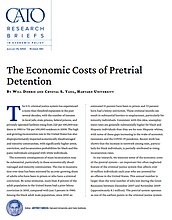The U.S. criminal justice system has experienced a more than threefold expansion in the past several decades, with the number of inmates in local jails, state prisons, federal prisons, and privately operated facilities rising from 220 per 100,000 residents in 1980 to 756 per 100,000 residents in 2008. The high and growing incarceration rate in the United States has also disproportionately impacted economically disadvantaged and minority communities, with significantly higher arrest, conviction, and incarceration probabilities for black and Hispanic individuals compared with white individuals.
The economic consequences of mass incarceration may be substantial, particularly in these economically disadvantaged and minority communities. The rise in incarceration over time has been mirrored by an ever-growing share of adults who have been in prison or who have a criminal conviction. By some estimates, more than 8 percent of the adult population in the United States had a prior felony conviction in 2010, compared with just 3 percent in 1980. Among the black adult male population, since 2010 an estimated 15 percent have been to prison and 33 percent have had a felony conviction. These criminal records can result in substantial barriers to employment, particularly for minority individuals. Consistent with this idea, unemployment rates are generally substantially higher for black and Hispanic individuals than they are for non-Hispanic whites, with some of these gaps increasing in the wake of economic recessions and the COVID-19 pandemic. Recent work has shown that the increase in nonwork among men, particularly for black individuals, is partially attributed to rising incarceration rates.
In our research, we measure some of the economic costs of the pretrial system—an important but often neglected feature of the criminal justice system that affects over 10 million individuals each year who are arrested for an offense in the United States. This annual number is larger than the total number of jobs lost during the Great Recession between December 2007 and November 2009 (approximately 8.1 million). The pretrial system operates as one of the earliest points in the criminal justice system and typically represents an individual’s first opportunity to be incarcerated. In theory, the pretrial system is meant to ensure the equitable release of most individuals before trial while minimizing the risk of flight or danger to the public. Despite this, defendants detained before trial represent over 75 percent of all jail inmates in some parts of the country, with significantly higher rates of pretrial detention among black and Hispanic individuals. The pretrial system has also faced increased public scrutiny in recent years due to the all-too-common stories of arrested individuals who, despite being first-time offenders accused of low-level crimes, spent months in pretrial detention and faced subsequent long-term damage in the form of family separation, work interruption, loss of housing, or even death. Pretrial detention can also generate substantial spillover effects, as the costs of paying money bail and other related court fees and fines often fall on other family and community members of detained individuals. Many of these harms can result even when the period of incarceration is brief and even if individuals are not ultimately convicted of any crime.
We measure the economic costs of the pretrial system using several complementary approaches and data sources. Using data from administrative tax records, we find that defendants are nearly 10 percentage points less likely to be employed in the formal labor market and less likely to take up social benefits, such as unemployment insurance or the earned-income tax credit, if detained before trial. Extrapolating these effects over a person’s working-age life cycle implies that individuals lose an average of $29,000 when detained in jail for just three days while awaiting the resolution of their criminal cases. These estimates suggest that reforms such as the elimination of money bail could potentially increase aggregate earnings by as much as $80.91 billion per year.
We also show that the adverse consequences of pretrial detention are present in aggregate measures of economic well-being. We compare changes in county-level poverty and employment-to-population rates with changes in county-level pretrial detention rates, and we find that a 10 percentage point increase in county pretrial detention rates between 2000 and 2009 is associated with a 1.41 percentage point increase in county poverty rates and a 2.06 percentage point decrease in county employment rates between 2000 and 2010. The relationship between changes in pretrial detention rates and changes in poverty and employment rates is generally unaffected when we add additional controls, and it is typically stronger for economic outcomes of demographic groups most likely to be affected by pretrial detention, such as working-age black individuals. These county-level estimates support the idea that bail reforms, such as the elimination of money bail, would likely result in economically meaningful improvements in wellbeing, as measured by poverty and employment rates, and would likely reduce racial gaps in economic well-being.
The final contribution of our work is a more tentative exploration into the long-run and intergenerational spillover effects of pretrial detention on young children. Although we caution that we are unable to control for many potential differences between low- and high-detention areas, we find that young children (ages 7–12) growing up in counties with high levels of pretrial detention experience significantly lower levels of intergenerational mobility when they reach adulthood. Specifically, we find that an increase of 10 percentage points in the pretrial detention rate in 1990 is associated with a 0.66 lower predicted income percentile for children born to parents at the 25th income percentile more than 20 years later. Our estimates are qualitatively unchanged with or without baseline controls, but there is no systematic pattern by race. Taken together, these findings suggest that pretrial detention adversely impacts young children who may be the dependents of detained individuals.
Note
This research brief is based on Will Dobbie and Crystal S. Yang, “The Economic Costs of Pretrial Detention,” Brookings Papers on Economic Activity, March 2021, https://www.brookings.edu/bpea-articles/the-economic-costs-of-pretrial-detention/.

This work is licensed under a Creative Commons Attribution-NonCommercial-ShareAlike 4.0 International License.

